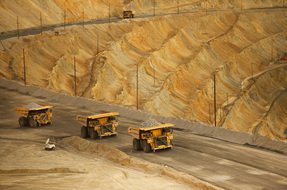Renewable energy continues to make inroads in the mining industry. There are now a large number of mining sites using renewable power to provide energy for their operations. And, many more evaluating potential renewable energy alternatives. In fact, this trend has gained momentum in recent years as the mining industry has focused on cutting costs and improving environmental performance. Over this period of early adoption, it has become apparent that due to the large energy needs and critical reliability and power quality requirements of mine operations, a microgrid approach to integrating renewable energy for mines is the most suitable. Renewable microgrids are the future.
However, the adoption of renewable microgrids to power mines is still lagging behind what should be expected. This is especially true for the sites using off-grid diesel power. Or, for the ones with poor grid availability as well as low power quality. There are a number of sites around the world that would significantly benefit from the use of renewable microgrids. Moreover, this number is increasing every year as technology improves and power costs from renewable microgrids continue to fall.
For renewable microgrids to reach their potential in the mining sector requires a clear understanding of the needs of mine owners as well as clear communication of the benefits of renewables.
The main benefits of renewable microgrids for mining sites are:
-
Simplicity
Generating power locally simplifies the logistics and supply chain for supplying energy to a mine site. Most renewable sources do not require fuel and have relatively light operations and maintenance requirements. This is especially true when compared to diesel generation. In these instances, one must manage the sourcing, transport, storage, and security of the fuel supply.
-
Environment Sustainability
Renewable energy generates very low emissions and local pollution. Improved environmental sustainability of a site can help obtain permits and permissions. It can also improve the relationships with local communities and stakeholders. Additionally, it can save on costs as carbon and other emissions may have (or will have in the future) direct costs associated with them (such as CO2 emission certificates).
-
Reliability
Microgrids can incorporate storage and demand management elements to improve the reliability of the power supply. Being located on-site makes the power generation and storage more resilient to interruptions elsewhere to a grid network or fuel supply chain. Renewable microgrids can also offer resilience to protect critical loads or services in the case of natural disasters.
-
Predictability
The costs of renewable generation are generally stable and predictable once a project is constructed. On the other hand, fossil fuel prices are extremely volatile. Fossil fuel price volatility, as demonstrated by the rapid drop in oil prices in the second half of 2014, makes estimating future costs difficult and highly uncertain. Even grid-supplied power can be heavily impacted by fossil-fuel price variability if fossil fuels provide a large proportion of the power mix.
-
Cost
In areas with good renewable resources, renewable microgrids are typically much lower cost than diesel generation and competitive with grid-supplied power. The cost savings from renewable microgrids can exceed 50% in remote locations. This cost advantage will only increase as fuel prices and central power costs continue to increase and can make a tremendous difference in the operational costs of a site.
What do renewable microgrids offer?
Renewable microgrids clearly offer significant benefits for mine owners, operators, and the local communities adjacent to sites. It is time for microgrid developers, suppliers, and integrators to work closely with the mining sector to further grow the sector and capture the tremendous value that renewable microgrids can bring to mine owners and operators.
By Arnaud Henin




